Thank you for visiting! By the way… any links on this page that lead to products on Amazon and other stores/partners are affiliate links Aquarium Store Depot earns a commission if you make a purchase.
Fish are fascinating creatures that come in practically every size, shape, and color (with over 35,000 species and counting discovered!)1. If you love fish-keeping, you’re probably just as fascinated by the natural world as we are, so today we’re going to dive into the weird and wonderful world of fish with big eyes!
Some of these species will do great in a fish tank in your bedroom, while others are true monsters of the deep sea.
Read along as we learn about 15 amazing types of big-eyed fish!
Key Takeaways
- There are both freshwater and saltwater fish with these traits
- Some examples are telescope goldfish, squirrel fish, and the giant squid
- Night Vision, hunting, and selective breeding are the main reasons for fish having big eyes
- Some of the fish on our list, while having large eyes, are not suitable for home aquariums
15 Amazing Fish With Big Eyes
Are you ready to meet some amazing big-eyed fish? We’ve chosen 15 fascinating fish from the coral reefs of the Pacific Ocean to brackish waters in South America. Read along to learn some fascinating facts about each one and why they have such big eyes.
So let’s dive right in!
1. Black Moor Goldfish
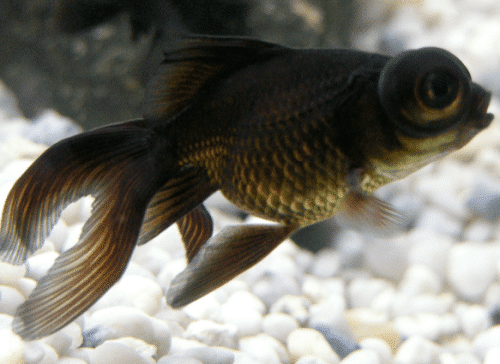
- Family: Cyprinidae
- Scientific name: Carassius auratus
- Size: 6 – 8 inches
- Water type: Freshwater
- Aquarium friendly? Yes
The black moor goldfish is a wonderful pet fish with some pretty extreme eyes. Unlike their wild ancestors, these fish are pure black with huge eyes and a double tail.
This fancy breed is the all-black version of the telescope goldfish. They thrive in cool water aquariums and are easy to find in pet stores worldwide.
Their huge eyes are the product of centuries of selective breeding. In fact, they were probably first bred in the 15th century in China and were brought to the United States in the 1800s.
2. Bubble-Eye Goldfish

- Family: Cyprinidae
- Scientific name: Carassius auratus
- Size: 3 – 5 inches
- Water type: Freshwater
- Aquarium friendly? Yes
The bubble eye goldfish is another amazing fancy goldfish breed. Just like the telescope goldfish above, these fish have been bred to have some pretty extreme features.
Bubble-eye goldfish have a huge, fluid-filled sack below each eye, which causes their large eyes to point upwards all of the time. These small freshwater fish also differ from regular goldfish by lacking a dorsal fin on their back.
3. Pufferfish
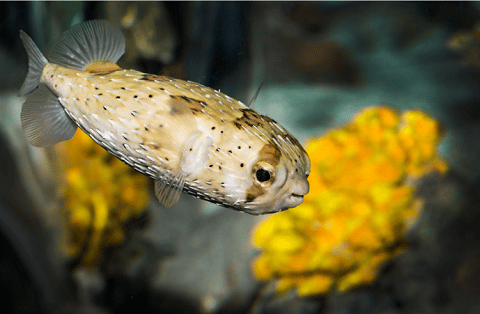
- Family: Tetraodontidae
- Scientific name: varied
- Size: 1 – 20 inches
- Water type: Fresh, brackish, and saltwater
- Aquarium friendly? Selected species
There are nearly 200 species of pufferfish in the world. Most of these unusual fish live in brackish and saltwater, although there are also some amazing freshwater species. Many pufferfish have huge eyes, but their most distinctive feature is probably their parrot-like beak.
Puffers really live up to their name when they get upset. These fish literally inflate with water or air to make themselves much larger and more difficult to eat. If a predator still wants to take a bite, these big-eyed fish are often highly toxic, so most fish prefer to leave puffers in peace!
4. Squirrel-Fish

- Family: Holocentridae
- Scientific name: Sargocentron spp.
- Size: 3 – 19 inches
- Water type: Saltwater
- Aquarium friendly? Selected species
Squirrel fish are tropical marine fish from the Holocentrinae subfamily. These fish can be common on coral reefs where they entertain divers with their beautiful colors and big eyes.
Some species, like the striped squirrel fish, make beautiful aquarium fish, although these guys prefer dark tanks. They are nocturnal and use their big eyes to detect their prey, like shrimp and other sea creatures.
5. Hawaiian Lionfish
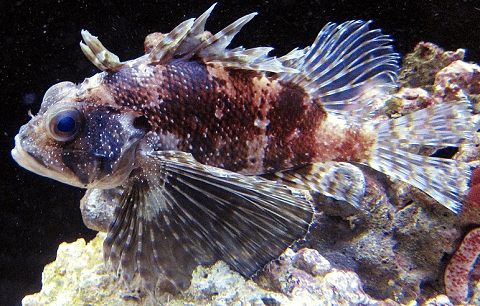
- Family: Scorpaenidae
- Scientific name: Dendrochirus barberi
- Size: 6.5 inches
- Water type: Saltwater
- Aquarium friendly? Yes, with caution
The Hawaiian lionfish is a beautiful but dangerous marine fish with big eyes and venomous spines. Their bright red eyes stand out against their well-camouflaged bodies on the coral reefs where they live.
The Hawaiian lionfish is native to the Pacific Ocean, where it lives in tropical waters from the shallows to about 400 feet down. The species is uncommon in the aquarium trade, although they could make an interesting reef fish for an experienced aquarist. Just watch out for those spines!
6. Bigeye-Fish

- Family: Priacantidae
- Scientific name: Pristigenys spp.
- Size: 8 – 20 inches
- Water type: Saltwater
- Aquarium friendly? Selected species
Bigeye fish are from the Priacanthidae family. Most species are red in color, and they have enormous eyes to help them detect prey after dark. These fish come from tropical and subtropical waters where they inhabit rocky areas.
7. Rockfish
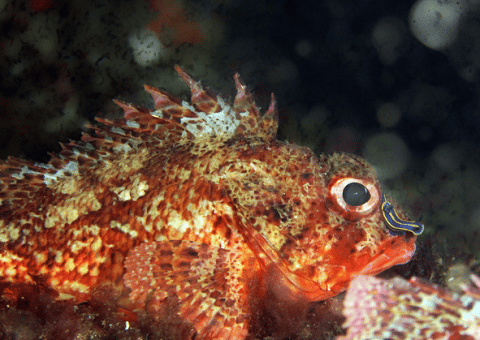
- Family: Scorpaenidae
- Scientific name: Varied
- Size: 6 inches to 4 feet
- Water type: Saltwater
- Aquarium friendly? Potentially
There are dozens of rockfish species that live around the coast of the US. These long-lived fish have huge eyes and very large mouths. Rockfish are common along rocky shores where they use their big eyes to detect their prey
Rockfish are very popular with fishermen, and some small species like the Puget Sound rockfish could even make a fascinating addition to a reef tank.
8. Bigeye Tuna
- Family: Scombridae
- Scientific name: Thunnus obesus
- Size: up to 8 feet
- Water type: Saltwater
- Aquarium friendly? No
The bigeye tuna (video source) is a magnificent marine predator that occurs across all temperate and tropical seas, including the waters around the USA. They are one of the largest tuna species and can weigh up to 400 pounds. Their incredible speed helps them catch the squid and other fish species they need to survive.
The bigeye tuna usually spends the daylight hours a thousand feet or more below the water surface but moves up to hunt at night- that’s where their large eyes really come in handy.
9. Blue Shark
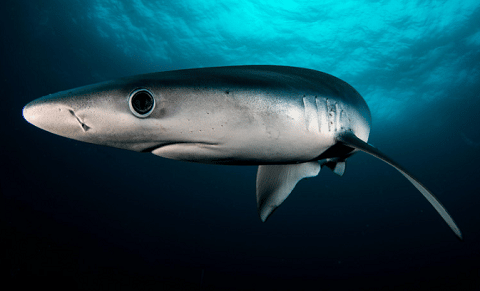
- Family: Carcharhinidae
- Scientific name: Prionace glauca
- Size: Up to 12 feet
- Water type: Saltwater
- Aquarium friendly? No
The blue shark is a large, streamlined fish that inhabits cool surface waters of the open ocean, down to about a thousand feet. Blue Sharks really are blue, although their sides are silver and their bellies are white.
Blue sharks have very large eyes, and their large black pupils create a cute, cartoon-like appearance. These predators are not exactly cuddly, but they are not usually dangerous to humans.
10. Jack-Fish

- Family: Carangidae
- Scientific name: Caranx latus
- Size: Up to 3 feet
- Water type: Saltwater
- Aquarium friendly? Suitable for large, public aquariums
The horse-eye jack is a large, predatory fish that hunts small fish and crustaceans in the oceans off the east and west coasts of North and South America. They are a popular sport fish, although they carry toxins that make them dangerous to eat. These powerful, deep-bodied fish are silver with a strongly forked, yellow tail. They are sight hunters who use their large eyes to spot their prey and attack with speed.
11. Thresher Shark
- Family: Alopiidae
- Scientific name: Alopias spp.
- Size: up to 20 feet
- Water type: Saltwater
- Aquarium friendly? No
The bigeye thresher shark (video source) is one of the coolest and strangest animals in the ocean. These sharks are instantly recognizable by their long tail, which can be as long as their whole body!
Bigeye thresher sharks can use their tails to generate great speed, and they can jump high out of the water. Their tails are used to strike their prey. Despite their sharp teeth, bigeye thresher sharks actually have adorable faces with huge dark eyes.
12. Swordfish
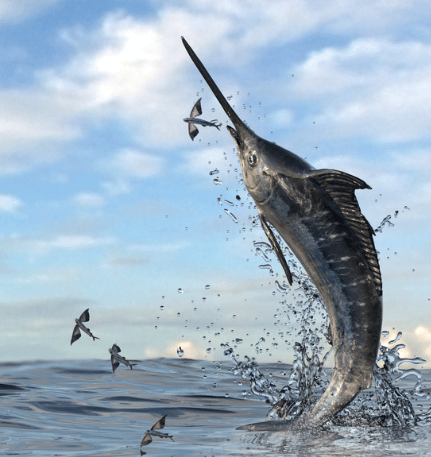
- Family: Xiphiidae
- Scientific name: Xiphias gladius
- Size: Up to 14 feet
- Water type: Saltwater
- Aquarium friendly? No
Swordfish are true monsters of the deep. These impressive fish have long, dagger-like bills that they use to kill their prey. Swordfish are one of the fastest fish on the planet, and they use their large eyes to locate prey in the dark depths where they hunt.
Swordfish occur in temperate, tropical, and subtropical waters in the Pacific, Indian, and Atlantic oceans. Unfortunately, swordfish are very difficult to see in the wild, although fishermen do catch them with hook and line and even with harpoons. This is one fish you don’t want to mess with!
13. Giant Squid

- Family: Arciteuthidae
- Scientific name: Architeuthis dux
- Size: Up to 43 feet
- Water type: Saltwater
- Aquarium friendly? No
No article on big-eyed creatures would be complete without mentioning the giant squid. These animals have the largest eyes on the planet1, reaching up to 10 inches across!
The giant squid is a beast of legend, although it absolutely does exist. Most of their incredible length is made up of their tentacles and their body reaches a little over seven feet long.
Giant Squids have giant eyes to match, and this helps them find their prey in the dark. However, they are not at the top of the food chain down there and are often eaten by Sperm Whales.
14. Brazilian Four-Eye
- Family: Anablepidae
- Scientific name: Anableps anableps
- Size: Up to 12 inches
- Water type: Brackish
- Aquarium friendly? Yes
The Brazilian Four Eye Fish actually has just two eyes, although their eyes have a pretty remarkable adaption. These strange-looking fish have two pupils in each eye, one below the other.
Amazingly, these large-eyed fish have the unique ability to swim at the water’s surface, with one pupil scanning the air above the water and the other looking below the water.
Although it is not suitable for beginners, these fish can be kept in large aquariums by experienced fish keepers.
15. Porbeagle Shark
- Family: Lamnidae
- Scientific name: Lamna nasus
- Size: 8 feet
- Water type: Saltwater
- Aquarium friendly? No
The Porbeagle shark looks much like the well-known great white, and only it maxes out at about 8 feet and 300 pounds. These fast-swimming sharks are a popular game fish species and are even harvested commercially for their meat and oil.
Porbeagles, like the other sharks in this list, have huge dark eyes that help them zero in on their prey which consists of smaller fish and other marine animals.
However, not all shark species need big eyes. Some larger shark species, like whale sharks and basking sharks, have pretty small eyes because they feed on slow-moving plankton. These gigantic sharks don’t need the sharp teeth of smaller species, and they are completely harmless to people.
Why Do Some Species Have This Trait?
There are many reasons for having big eyes, but the most important reason is to improve vision. Keep reading to learn about four reasons why some fish have big eyes.
Night Vision
Big eyes really come in useful for seeing in dim light. Just like owls and other animals that hunt at night have big eyes, many fish that live in the dark need outsized eyes to see their predators and prey.
Nocturnal fish like squirrelfish and species that live in deep water like the adorable Genie’s dogfish use their big eyes to focus light and find food in low-light conditions.
Hunting
Even regular game fish like barracuda fish that hunt in daylight hours benefit from having big eyes.
These fish live life in the fast lane, where having sharp eyesight and great speed can make the difference between getting a meal or going hungry.
Selective Breeding
Some fish with big eyes are the result of breeding projects by fish keepers and farmers. Just like humans have bred dogs into all the amazing types we have today, fish breeders can develop interesting fishy features by selectively breeding for those traits.
Goldfish are a great example, and the strange but beautiful telescope goldfish have some of the biggest eyes of any freshwater fish, thanks to humans rather than nature.
Health Conditions
Sometimes pet fish develop a health condition known as exophthalmia. This common but alarming problem is often called popeye by fish keepers, and it results from trauma, infection, or poor water quality.

Popeye is a serious condition, and it can cause permanent damage or even the loss of the eye if left untreated. However, if an injury caused the problem, time might be all your fish needs to heal up.
If your fish has popeye, test your water quality to see if all your parameters are safe and healthy. Treatment with Epsom salts to reduce swelling or antibiotics to fight an underlying infection can be helpful.
Why Do Some Fish Have Small Eyes?
You might be wondering why all fish don’t have big eyes. Surely all species would benefit from having great vision, right?
Many bottom-dwelling fish like loaches and catfish have pretty small eyes because they rely on their sense of smell and touch to navigate the world around them. Big eyes don’t really help in very murky waters either, so these fish have evolved to rely on their other senses.
In some cases, fish don’t use their eyes at all. The blind cave tetra from Mexico lives in complete darkness, where eyes are useless.
FAQs
What are the animals with these eyes called?
Fish with big eyes do not have any specific scientific classification. This trait has evolved in many different bony fish and cartilaginous fish families from deep oceans to shallow waters around the world.
Which of these species are from the Gulf?
The gulf of Mexico is home to several species with big eyes, including swordfish, horse-eye jacks, and big-eye tuna to name just a few.
Which of these are from the Caribbean?
Tropical waters of the Caribbean are home to many impressive big-eyed gamefish, as well as tropical reef fish like squirrelfish.
Why do some have this trait?
Most fish that have big eyes are nocturnal predators or live in deep waters where it is always dark. Big eyes allow more light through to the optic nerve, allowing better vision.
Why is my fish’s eye getting big?
Popeye is a common but alarming condition that affects pet fish from time to time. There are various causes, ranging from physical injury to infection.
The eye of the affected fish bulges out because fluid builds up behind the eye, causing pressure. If just one eye is affected, your fish has probably suffered trauma from a collision or aggression from a tank mate. When both eyes swell, it could be a sign that water quality is low.
What is the name of a small species with this trait?
The dwarf pufferfish (AKA pea puffer) is a great example of a small fish with big eyes. These awesome freshwater fish have tiny bodies, growing to just an inch or so, and they make great pet fish.
Dwarf Puffers can be kept in aquariums as small as 10 gallons, and they do best if kept alone or in a larger tank with other members of their own species.
Final Thoughts
Big-eyed fish species are found everywhere from the tropical oceans to your local fish store. With over 30, 000 fish species on the planet, this list is just a drop in the ocean, but hopefully, you’ve enjoyed this look at 15 amazing types!
What is your favorite fish species with big eyes? Let us know in the comments below!
- About the Author
- Latest Posts
I’m thrilled that you found Aquarium Store Depot! Here you’ll find information on fish, aquariums, and all things aquatics related. I’m a hobbyist (being doing this since I was 11) and here to help other hobbyists thrive with their aquariums! I adhere to a high quality Editorial Process and Review products with real life field usage and practical analysis.





